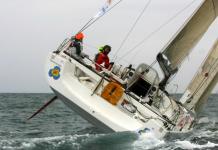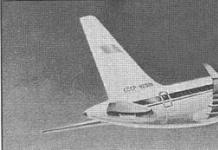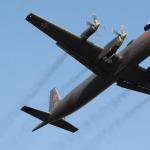It has become a successful and durable car. However, the basic model was “outlived” by military modifications. These included not only the Il-20 radio reconnaissance aircraft.
The passenger car became the basis for the Il-38 anti-submarine aircraft. Developed back in the 60s as a response to the growing power of submarine missile carriers, the Il-38 has not lost its significance in the 21st century. The vehicles remain in service and are undergoing modernization programs. And, together with the Tu-142 long-range aircraft, they remain the basis of anti-submarine defense.
History of creation
In the 50s, the United States launched a large-scale program for the construction of nuclear submarines armed with ballistic missiles. Initially, it was decided that the Soviet fleet should neutralize the threat. However, the navy did not have enough ships to monitor all possible areas. But the Soviet Union did not have the opportunity to deploy a hydroacoustic surveillance system. As a result, it was decided to rely on aviation. Sergei Ilyushin's design bureau received the task of developing an anti-submarine aircraft in the summer of 1960.
According to the project, the future Il-38 was supposed to be able to conduct three-hour patrols at a distance of over 2000 km from the base. For reasons of economy, they decided to build the aircraft not from scratch, but based on existing ones. In this case, the Il-18 airliner was suitable for the role of the “base”, more specifically, its modification of the improved layout of the Il-18V.
The revised technical specifications were approved in the spring of 1961, and the first prototypes, still without special equipment, had to be built by 1962. As for equipment, in 1961 only the defense of the search system project took place, and it was assessed as very promising.
Initially, they wanted to use the Il-38 as a multi-purpose aircraft, armed with anti-ship missiles and capable of performing reconnaissance missions, but design bureau employees objected to this.
In their opinion, the installation of underwing weapons suspension units would unacceptably increase the load on the wing. And the installation of radio reconnaissance equipment will lead to the fact that the aircraft and crew will perform a variety of functions, but not “anti-submarine” functions. And it will end in wear and tear of the cars and loss of qualifications by the crews. As a result, it was decided to leave the Il-38 as a purely anti-submarine aircraft, armed with mines and torpedoes.
The first flight of the Il-38 with a crew led by Vladimir Kokkinaki took place ahead of schedule - in the fall of 1961. During factory tests, which lasted until the summer of 1962, they made 77 flights, flying 135 hours. In the fall of 1962, the second prototype took off, also without special equipment. By this time, the Berkut system was still being tested on board flying laboratories based on the Il-18. And not even the entire system, but only its individual components.
It so happened that although the plane itself took off ahead of schedule, testing of on-board systems began almost a year late. Flights in 1964 revealed that the Berkut still needed serious fine-tuning.
State tests of the aircraft took place in 1965. The IL-38 was decided to be suitable for production launch, but not for adoption. We decided to hold off on the second point until the reliability of the Berkut system was improved. As a result, the anti-submarine aircraft became operational only in 1969.
Design
The Il-38 anti-submarine aircraft is a low-wing monoplane with four turboprop engines. The combat vehicle is slightly different from the base Il-18 - for example, the wing had to be moved forward. At the front of the fuselage there is a pressurized cabin. There are seats for the pilots, flight engineer, navigator and radio operator.
In the rear part of the cabin there is equipment for the Berkut system and places for its two operators, and they sit with their backs in the direction of flight. The cabin is entered through hatches in the floor; in the event of an emergency splashdown, hatches in the roof and side are used. Under the fuselage of the Il-38 there is a radar radome.
Behind the pressurized cabin there are 2 bomb bays in which mines, torpedoes and buoys are suspended. 2 soft-type fuel tanks are installed above the front compartment. Behind the bomb bays there is auxiliary equipment - oxygen cylinders, batteries, APU and life raft.
Engine nacelles and landing gear supports are installed on the center section of the Il-38 wing, and fuel tanks are located between the wing spars.
The wing is equipped with double-slotted flaps and ailerons; an anti-icing system (electric) runs along the wing tip. The plumage is single-finned, all-metal. The three-post chassis is retracted using a hydraulic drive; only the main pillars are equipped with brakes (disc).
AI-20M turboprop engines are equipped with 4-blade variable-pitch propellers; in cruising mode, the engines develop a power of 2,700 hp. The automatic fire extinguishing system fights fires in the engine nacelles or in the auxiliary power unit compartment. In case of fire, there are 2 fire extinguishers in the cockpit. The aircraft control system is mechanical, using rigid rods. The steering gears of the AP-6E autopilot are connected in parallel to the elevators, direction, and ailerons.
The “heart” of the Berkut system was the central computer TsVM-264. She could control the flight and process data received from radar and buoys. Target tracking and weapon release were carried out automatically. To detect boats, a panoramic radar was installed on the Il-38, and buoys were used in 3 models - RSL-1 - passive, non-directional. RSL-2 is also passive, but already directed. The RSL-3 buoy additionally had an active operating mode.
For the Il-38, the AT-2 homing torpedo, guided by an acoustic signal, was developed. It is possible to use anti-submarine bombs with a caliber of up to 120 kg, including adjustable ones.
Exploitation
Crew training for the Il-38 began back in 1967, before the aircraft was put into service. And since 1968, the Northern Fleet began to receive anti-submarine aircraft. The car itself, being built on a successful and proven platform, did not cause any complaints. Unfortunately, the same couldn't be said for the hardware. The Berkut system was still unreliable - it accounted for up to 60% of all failures. And the complex’s computer worked until failure for only 6 hours.
Of the RSL-1 buoys, 20% were rejected in 1969, and the RSL-2 buoys turned out to be so unprotected from interference that in some cases the true target was not recognized at all.
But these problems were gradually resolved. What was worse was that when the Il-38 was designed, it was expected that the missile-carrying submarines would operate in coastal areas. This was not confirmed, and after the adoption of missiles with a longer launch range, the boats moved so far from the coast that the “thirty-eighth” could no longer monitor them.
In the period from 1970 to 1972, the special purpose squadron based in Egypt (then UAR) achieved great success in detecting and observing submarines. After the squadron's withdrawal from Egypt, Il-38 aircraft flew over the Indian Ocean, taking off from Yemen and Ethiopia. And we managed to continue flights over the Mediterranean Sea by agreeing with Libya.

After the collapse of the Soviet Union, some anti-submarine regiments and squadrons were disbanded. The number of sorties and the frequency of detection of submarines were constantly decreasing. The situation began to change for the better only in the 21st century, when the remaining Il-38s began to be modernized, equipped with the Novella complex. In the 70s, a batch of “thirty-eighths” was sold to India. In the 90s they were modernized and received the IL-38SD index.
Flight performance
The Il-38 is often compared to the American Orion aircraft, which has been in service since the early 60s. The comparison is not very accurate, but the domestic car does not have a closer foreign analogue.
The reason why Orion is not a complete analogue of the IL-38 is simple. It was created within the framework of precisely the concept that the creators of the domestic torpedo bomber objected to. Orion is a multi-role patrol aircraft equipped with a more diverse range of equipment. Unfortunately, this equipment was also superior to Soviet equipment in terms of perfection.
Despite problems with the modification of radio-electronic equipment, the Il-38 gained recognition and respect among naval aviation pilots.
Although the Tu-142 “pulled off” a more prominent role, the “thirty-eighth” survived the most difficult years and continues to improve.
Video
Anti-submarine and patrol aircraft Kawasaki P-1.
Japan, being a “seemingly” peace-loving state, devoid of any militarism and having a provision in the Constitution prohibiting the use of military force as an instrument of policy, nevertheless has a powerful military industry and a large and well-equipped Armed Forces, formally considered the Self-Defense Forces.
To characterize the latter, let's give a couple of examples.
Thus, the number of warships in the far sea and ocean zones of the Maritime Self-Defense Forces exceeds that of all Russian fleets combined. And also Japan has the largest anti-submarine aircraft in the world after the United States. Neither Britain, nor France, nor any other country except the United States can even come close to Japan in this parameter.
And if the United States is superior to Japan in terms of the number of basic patrol aircraft, then who is superior to whom in quality is an open question.
From the point of view of assessing what the real military-industrial potential of Japan is, a lot of information is provided by one of the most ambitious military projects of this country - Kawasaki P-1 basic patrol aircraft. The largest and perhaps the most technically advanced anti-submarine and patrol aircraft in the world.
Let's get to know this car.
Having been defeated in World War II and being occupied by the United States, Japan for many years lost its independence both in its politics and in its military development. The latter was reflected, among other things, in the strong “bias” of the Navy of the Self-Defense Forces towards anti-submarine warfare. This “distortion” did not arise out of nowhere - it was precisely such an ally near the USSR that the Japanese masters, the Americans, needed. It was required because the Soviet Union was making an equally strong “lean” towards the submarine fleet, and in order for the US Navy to fight the USSR Navy without diverting excessive resources to anti-submarine defense forces, the American satellite Japan grew such forces at home and at its own expense .
Among other things, these forces included basic patrol aircraft armed with anti-submarine aircraft.
At first, Japan simply received outdated equipment from the Americans. But in the 50s, everything changed - the Japanese consortium Kawasaki began work on obtaining a license to produce something already known to the Self-Defense Forces anti-submarine aircraft P-2 Neptune. Since 1965, Japanese-assembled Neptunes began to enter naval aviation and until 1982, the Self-Defense Forces Navy received 65 of these vehicles, assembled in Japan using Japanese components.
Since 1981, the process of replacing these aircraft with P-3 Orion aircraft. It is these aircraft that still form the backbone of Japanese base patrol aircraft. In terms of their tactical and technical characteristics, Japanese Orions are no different from American ones.
However, since the 90s, new trends have emerged in the creation of combat aircraft, including naval ones.
Firstly, the United States has made a breakthrough in methods for radar detection of disturbances on the sea surface generated by a submarine moving underwater. This has already been written about several times, and we will not repeat it.
Secondly, methods for processing information collected by an aircraft through various channels - radar, thermal, acoustic and others - have stepped forward. If earlier the operators of the anti-submarine complex had to independently draw conclusions from analog signals on the screens of radars and primitive heat direction finders, and acousticians had to listen to the sounds transmitted by sonobuoys, now the on-board computer complex of the aircraft independently “fused” the signals coming from different search systems, converted them into a graphical form, “cut off” the interference and displayed ready-made zones for the supposed location of the submarine to the operators on the tactical screen. All that remained was to fly over this point and drop a buoy there for control.
The development of radars has stepped forward sharply, active phased array antennas have appeared, in the development and production of which Japan has been and remains one of the world leaders.
It was impossible to modernize the Orions so that all this wealth could fit on board. The computer complex alone promised to “eat up” all the free volumes inside, and a full-fledged radar of the level that Japan could afford simply would not fit on the plane at all, and in 2001 Kawasaki began work on a new machine.
The project was named R-X.
By that time, the Japanese industry was already cramped within the existing framework, and in addition to the anti-submarine aircraft, the Japanese, as part of the same project, began to make a transport aircraft partially unified with it - the future S-2, the Japanese replacement for the Hercules. The unification turned out to be quite strange, exclusively for secondary systems, but this no longer mattered, because both projects, as they say, worked out.
 Anti-submarine R-1 and transport S-2. Do you see the unification? And she is! The glass of the cabins, for example, is the same. Saved 7% on system commonality
Anti-submarine R-1 and transport S-2. Do you see the unification? And she is! The glass of the cabins, for example, is the same. Saved 7% on system commonality
The project was developed almost simultaneously with the American Boeing P-8 Poseidon aircraft, and the Americans offered the Japanese to buy this aircraft from them, but Japan rejected this idea, citing - attention - the inconsistency of the American aircraft with the requirements of the Self-Defense Forces. Considering how advanced the Poseidon was being developed (not to be confused with the crazy nuclear torpedo), it sounded funny.
On September 28, 2007, R-1 (then R-X) made its first successful one-hour flight. No noise, no press and pompous events. Quiet, like everything the Japanese are doing in terms of increasing their combat capabilities.
 The first prototype of the P-X in TRDI colors.
The first prototype of the P-X in TRDI colors.
In August 2008, Kawasaki had already transferred a test aircraft to the Self-Defense Forces, by that time it had already been renamed XP-1 in the American manner (the X is the prefix meaning “experimental”; everything that comes next is the serial index of the future aircraft) . In 2010, four prototypes were already flying in the Self-Defense Forces, and in 2011, based on the experience gained during testing, Kawasaki repaired and modernized the already built machines (the airframe had to be strengthened and a number of other shortcomings eliminated), and made changes to the documentation for the new ones.
The plane was ready for mass production and it didn’t take long to wait, and On September 25, 2012, the first production aircraft for the Maritime Self-Defense Forces took to the skies..
Let's take a closer look at this car.
The aircraft fuselage is built using a large number of composite structures. The wing and aerodynamics as a whole are optimized for flights at low speeds at low altitudes - this distinguishes the aircraft from its American counterpart P-8 Poseidon, which operates from medium altitudes. The fuselage itself is created jointly by Kawasaki Heavy Industries (fuselage nose, horizontal stabilizers), Fuji Heavy Industries (vertical stabilizers and wings in general), Mitsubishi Heavy Industries (middle and rear fuselage), Sumimoto Precision products (chassis).
R-1 is the first aircraft in the world whose EMDS transmits control signals not through digital data buses on “loop” cables, but through optical fiber. This solution, firstly, speeds up the performance of all systems, secondly, it simplifies the repair of the aircraft if necessary, and thirdly, the optical signal transmitted via an optical cable is much less susceptible to electromagnetic interference. The Japanese are positioning this aircraft as having increased resistance to the damaging effects of nuclear weapons, and the elimination of wires in key circuits of the control system certainly played a role.
The aircraft's airframe is unique in the sense that it is not a modification of a passenger or cargo vehicle, but was designed from scratch specifically as an anti-submarine aircraft.
In terms of its dimensions, the aircraft is close to a 90-100 seat passenger aircraft, but it has four engines, which is atypical for aircraft of this class, and a reinforced structure, which is logical for a specially designed aircraft. The R-1 is significantly larger than the American Poseidon.
The core of the aircraft's sighting and search system is the Toshiba/TRDI HPS-106 AFAR radar. This radar was jointly developed by Toshiba Corporation and TRDI, Technical Research and Development Institute, a research organization of the Japanese Ministry of Defense.
The specificity of this radar is that in addition to the main antenna with AFAR installed in the nose of the aircraft, it has two more canvases installed on the sides, under the cockpit. Another antenna is installed at the tail of the aircraft.

 Nose cone and side radar array with AFAR
Nose cone and side radar array with AFAR
The radar is all-mode and can operate in both aperture synthesis mode and inverse aperture synthesis mode. The characteristics and location of the antennas provide a 360-degree view at any given time. It is this radar that “reads” those wave effects on the surface of the water and above it, thanks to which modern anti-submarine aircraft simply “see” the boat under water. Naturally, detecting surface targets, periscopes, RPD devices fired by submarines, or air targets is absolutely not a problem for such a radar.
A retractable rotary turret with the FLIR Fujitsu HAQ-2 optical-electronic system is installed in the nose of the aircraft. It is based on an IR television camera with a target detection range of 83 kilometers. A number of other television cameras are installed on the same turret.

 It can be seen that the turret can not only be raised and lowered, but also rotated.
It can be seen that the turret can not only be raised and lowered, but also rotated.
An ordinary magnetometer is installed in the tail of the plane - unlike the Americans, the Japanese did not abandon this search method, although it is rather needed for verification, and not as the main tool. The aircraft's magnetometer responds to a typical steel submarine within a radius of approximately 1.9 km. The magnetometer is a Japanese copy of the Canadian CAE AN/ASQ-508(v), one of the most efficient magnetometers in the world.
 The magnetometer rod is very clearly visible.
The magnetometer rod is very clearly visible.
Naturally, in order to instantly convert signals from the radar, IR camera and magnetometer into a single intended target, and to draw this intended target on the screens displaying the tactical situation, large computing power is needed and the Japanese placed a fairly large computing complex on the plane, fortunately the sit is here. This, by the way, is a powerful trend - really large computers are being installed on airplanes, and it is necessary to provide both space and power supply for them in advance, work on their cooling and electromagnetic compatibility with other aircraft systems. The same thing was done in Poseidon.
The cabin is equipped with high-quality Japanese-made equipment. It is noteworthy that both pilots have HUDs. For comparison, in Poseidon only the commander has it.
 Cockpit. Are any comments needed here?
Cockpit. Are any comments needed here?
At the same time, the Americans have implemented a blind landing mode, when a virtual image of the terrain over which the plane is flying is displayed on the HUD, as if the pilot actually saw it through the window, and relative to this image the plane is positioned perfectly accurately and without time lags.
Thus, if there are virtual models of the terrain around the airfield at which the landing is being made, the pilot can land the plane in absolutely zero visibility and without the help of ground services. It simply makes no difference to him whether there is visibility or not, the computer will give him a picture in any case (if it is stored in memory for a given location). It is possible that the R-1 also has such functions, at least the computing power on board allows them to be provided.
The aircraft is equipped with a Mitsubishi Electric HRC-124 radio communications system and a Mitsubishi Electric HRC-123 space communications system. A MIDS-LVT communication and information distribution terminal compatible with Datalink 16 is installed on board, with the help of which the aircraft can automatically transmit and receive information from other Japanese and American aircraft, primarily from Japanese F-15J, P-3C, E-767 AWACS , E-2C AEW, carrier-based helicopters MH-60, F-35 JSF.
 Small terminal of the multifunctional information distribution system MIDS-LVT for integrating the aircraft into the Datalink 16 mutual information exchange system. Truly important things sometimes look unassuming.
Small terminal of the multifunctional information distribution system MIDS-LVT for integrating the aircraft into the Datalink 16 mutual information exchange system. Truly important things sometimes look unassuming.
The “brain” of the aircraft is the Toshiba HYQ-3 Combat Control System – this is the core of the search and targeting system. Thanks to it, disparate groups of sensors and transducers are “merged” into a single complex, where each element of the system complements each other. Moreover, the Japanese have compiled a huge library of tactical algorithms for performing anti-submarine missions, and have developed “artificial intelligence” - an advanced program that actually does part of the work for the crew, providing ready-made solutions for finding and destroying a submarine.
However, the work post of a tactical coordinator - a living officer capable of commanding an anti-submarine operation, controlling the entire crew based on the data received and processed by the aircraft - is also there. It is not known whether there is a radio intelligence operator on board, but, according to the experience of the Americans, this cannot be ruled out. The standard crew of 13 people exclusively for hunting submarines is frankly too big.

 Combat posts
Combat posts
The plane, as befits an anti-submarine officer, has a supply of sonar buoys, but the Japanese did not copy the American design - neither new nor old.
Once upon a time, Americans loaded buoys into launch silos mounted in the bottom of the fuselage. One shaft - one buoy. Such a scheme was needed so that the reconfiguration of the buoys could be carried out directly in flight, which distinguished the Orion from the Russian Il-38, where the buoys were located in the bomb bay and where they could not be adjusted to the waves during the flight.
 Loading buoys into Orion launch silos. The R-1 can do this too, and the main thing is that the buoy can be adjusted before dropping.
Loading buoys into Orion launch silos. The R-1 can do this too, and the main thing is that the buoy can be adjusted before dropping.
In the new Poseidon, the United States, having mastered new methods of warfare, abandoned this method of deployment, limiting itself to three 10-charge rotary launchers and three shafts for manual release. And the Japanese had rotary installations, and shafts for manual release, and a rack for 96 buoys, and, at the same time, a 30-charge launcher in the bottom of the aircraft, similar to the Orion. Thus, the R-1 has certain advantages over its American counterpart.
 On the left are two rotary launchers for sonobuoys. It is very convenient when setting a small number of buoys in one gulp - 4-5 pieces. One at a time is possible.
On the left are two rotary launchers for sonobuoys. It is very convenient when setting a small number of buoys in one gulp - 4-5 pieces. One at a time is possible.
 Rack for buoys. The mount is like the Americans, maybe even purchased. The buoys are positioned so that they can be adjusted before being dropped directly in the rack - and immediately into the launch pad.
Rack for buoys. The mount is like the Americans, maybe even purchased. The buoys are positioned so that they can be adjusted before being dropped directly in the rack - and immediately into the launch pad.
 And these are launch silos for setting up a “field” of buoys. This field can work like one huge antenna.
And these are launch silos for setting up a “field” of buoys. This field can work like one huge antenna.
 Placing buoys
Placing buoys
The aircraft is equipped with a Mitsubishi Electric HLR-109B electronic reconnaissance system, which allows it to detect and classify the radiation of enemy radar stations, and can be used as a reconnaissance aircraft.
 Antenna system
Antenna system
The defense system of the Mitsubishi Electric HLQ-9 aircraft consists of a radar warning subsystem, an incoming missile detection subsystem, a jamming complex and fireable IR decoys.
 On defense
On defense
The aircraft engines are also of interest. The engines, like most aircraft systems, are Japanese, designed and manufactured in Japan. At the same time, interestingly, the Japanese Ministry of Defense was announced as the engine developer. The manufacturer is Ishikawajima-Harima Heavy Industries - IHI, another major Japanese corporation, produces a huge range of industrial products, including a wide range of aircraft engines.
The engine of the F7-10 model is small in size, lightweight and has a thrust of 60 kN each. With four such engines, the aircraft has good take-off characteristics and increased survivability compared to a twin-engine aircraft. Engine nacelles are equipped with sound-reflecting screens.



The plane surpassed the Orion in terms of noise level - the R-1 is 10-15 decibels quieter.
The aircraft has a Honeywell 131-9 auxiliary power unit.
 Armed Forces of Ukraine
Armed Forces of Ukraine
 The first hole is the APU air intake, the second is the exhaust.
The first hole is the APU air intake, the second is the exhaust.
The weapons that an aircraft can carry and use are quite varied for a patrol vehicle.
The weapon can be located either in a compact weapons compartment in the front part of the aircraft (designed mainly for torpedoes), on eight hardpoints, or on removable underwing pylons, the number of which can also reach up to eight, four per wing. The total mass of the combat load is 9000 kg.
Type 97 torpedo
 RCC ASM-1C
RCC ASM-1C
 AGM-65 Maverick
AGM-65 Maverick
The recently adopted supersonic “three-mach” anti-ship missile ASM-3 is not declared as part of the aircraft’s weapons, but this should not be ruled out. To destroy small targets at short range, the aircraft can carry the AGM-65 Maverick missile, also made in America.
Torpedo armament is represented by American small-sized anti-submarine torpedoes Mk.46 Mod 5, some of which may still remain with the Japanese, and Japanese Type 97 torpedoes, with a caliber of 324 mm, the same as the American torpedo. The future torpedo, currently being developed under the designation GR-X5, has already been announced in advance as part of the armament.
There is no information that the aircraft can use torpedoes equipped with a gliding device, like the Americans, but this cannot be ruled out, given the complete identity of the Japanese and American communication protocols on which military electronics and weapon suspension devices operate. It is also possible to use depth charges and sea mines from an aircraft. It is unknown whether the aircraft is adapted for the use of depth charges with a nuclear warhead.
Interesting, but it seems the Japanese have abandoned the use of in-flight refueling. On the one hand, a flight range of 8000 km allows this to be done, on the other hand, it reduces the search time, which is an extremely negative factor. One way or another, the plane cannot take fuel in the air.
 P-8 Poseidon and Kawasaki P-1 side by side. It can be seen that the Americans have better access to the plane, and therefore emergency exit is more convenient. On the other hand, while it hasn't fallen, Kawasaki may be better.
P-8 Poseidon and Kawasaki P-1 side by side. It can be seen that the Americans have better access to the plane, and therefore emergency exit is more convenient. On the other hand, while it hasn't fallen, Kawasaki may be better.
Currently, all P-1s are based at Atsugi Air Base, Kanagawa Prefecture.
As is known, as part of its policy towards militarization, Japan plans to abandon a significant part of the restrictions on its own military-technical development in 2020. Both Prime Minister Shinzo Abe and members of his cabinet have spoken about this more than once. As part of this approach, Japan has more than once offered a new aircraft for export (while Japan's export of weapons is prohibited by its own Constitution). But it has not yet been possible to defeat the American Poseidon - both in terms of political and technical factors. Poseidon, although simpler in some ways, apparently wins in terms of life cycle cost.
However, the story of the R-1 is just beginning. Experts are confident that the P-1 will be one of the means by which Japan will make its way into world arms markets, along with Soryu-class submarines equipped with an air-independent power plant and the US-2 ShinMayva seaplane.
It was originally planned that 65 such aircraft would be ordered. However, after receiving the first 15 cars, the purchases stopped.
This is all the more surprising given that the Chinese submarine fleet is growing. The usual belief of any analyst dealing with the military development of Asian states is that the growth of Japanese military power is a response to the growth of that of China. But for some reason, there is no correlation between the development of the Chinese submarine and the Japanese base patrol aircraft, as if in reality Japan has a different adversary in mind.
However, as Ryota Ishida, a senior official of the Japanese Ministry of Defense, said in the spring of 2018, up to 58 aircraft will sooner or later be put into service “in the long term,” but now Japan has no plans to increase the number of anti-submarine defense aircraft.
One way or another, the Kawasaki P-1 is a unique program that will still leave its mark on Japanese naval aviation. And it is quite possible that this plane will also fight.
I wish I knew against whose submarines.
And on-board means of working with them (workplaces of RGP operators), which make it possible to detect submarines by the noise of propellers and sonar radiation;
PLS are usually part of naval aviation - in the Russian Federation it is Navy aviation, in the USA - the US Navy, in India - the Indian Navy, etc. Anti-submarine aircraft are based at airfields located near the sea - in Russia these are airfields of the Northern Fleet (current in the Atlantic and Arctic Oceans) Severomorsk-1 and Kipelovo, located near Murmansk and Vologda, respectively, and the airfields of the Pacific Fleet Kamenny Ruchey (located near Sovetskaya Gavan and Nikolaevka (about 150 km from Vladivostok). Il-38, in Kipelovo and Kamenny Ruchey - Tu-142MK.
IL-38. The magnetometer fairing on the tail and the radar fairing under the cockpit are visible

Workplaces for operators of the Tu-142MK-Z RGP
Sources
- Product VPMK. Technical description
The Avro Shackleton is a four-engine piston anti-submarine patrol aircraft of the Royal Air Force, developed by Avro on the basis of the World War II Avro Lincoln bomber.
Used from 1951 to 1990 as an anti-submarine warfare (ASW), maritime patrol aircraft (MPA), airborne early warning (AEW), search and rescue (SAR) aircraft ) and in other roles. The aircraft was also operated by the South African Air Force from 1957 to 1984.
Named after the polar explorer, Sir Ernest Shackleton
Boeing P-8 PoseidonBoeing P-8 Poseidon (Russian: Boeing P-8 Poseidon) is an anti-submarine patrol aircraft developed under the multimission maritime aircraft (MMA) program to replace the Lockheed P-3 Orion. Designed to detect and destroy enemy submarines in areas of patrol, reconnaissance, participation in anti-ship and rescue operations - both in coastal areas and in the World Ocean. It is based on the design of the updated Boeing 737-800 airliner. It is distinguished from its progenitor by a wing that is devoid of winglets, but has tips with increased sweep.
Breguet AlizeBreguet Br.1050 "Alize" (French Breguet Br.1050 Alizé - Passat) - French carrier-based anti-submarine aircraft.
Fairey GannetFairey Gannet (eng. Fairey Gannet - Gannet) is a British carrier-based anti-submarine aircraft and AWACS aircraft. Designed and produced by Fairey Aviation Company. Operated from 1953 to 1978. Operators: British, Australian, Indonesian, and German Navy.
Grumman S-2 TrackerGrumman S-2 Tracker (eng. Grumman S-2 Tracker, until 1962 - S2F) is an American carrier-based anti-submarine aircraft.
The S-2 was the first US Navy aircraft to be equipped with both submarine detection and destruction capabilities. The S-2's predecessors had separate detection and attack functions; the AF Guardian anti-submarine system consisted of two aircraft of the same type, one of which carried a radar, and the second carried anti-submarine torpedoes.
Jezebel (hydroacoustic system)Jezebel (also LOFAR English. LOw Frequency Analysis and Recording, low-frequency analysis and recording) is a passive sonar designed to search for submarines and hydroacoustic surveillance of water areas. Up to 16 passive sonar buoys were placed in the controlled area, which picked up acoustic vibrations from submarines and other objects and relayed it via a VHF radio channel to an anti-submarine aircraft. Comparing signals from different buoys made it possible to determine the exact coordinates of the target. Spectral analysis of signals (extraction of an acoustic signature) also made it possible to classify the target and determine its nationality.
The Jezebel system used AN/AQA-3 and AN/AQA-4 recorders. AQA-3 consisted of four 76 mm printing devices arranged in a line, which printed on a wide tape the dependence of the signal spectrum on time (on the X axis - frequency, on the Y axis - time). Unlike the AQA-3, the AQA-4 had an additional button for establishing communication.
Julie (hydroacoustic system)Julie is an active bistatic sonar designed to search for submarines. Used ERR technology (English Explosive Echo Ranging, determining range by echo signal from an explosion). The sources of the sounding signal were practical charges (small-caliber depth charges), and the receivers were hydroacoustic buoys of various types (AN/SSQ-2, AN/SSQ-23). The hydroacoustic signal was relayed via a VHF channel to an anti-submarine aircraft, where it was processed to determine the types and coordinates of underwater objects.
Before sounding, the anti-submarine aircraft installed sonar buoys in the water area under study, and then detonated several small-caliber depth charges, called Practice Depth Charges (PDC). The direct and reflected acoustic signal from the submarine was received by buoys and printed on paper tape. Using special rulers calibrated depending on water temperature (Julie rulers), operators determined the distance from the target to the corresponding buoy. The distance to the two buoys made it possible to determine the coordinates of the boat, but this created ambiguity (the boat could be at any of two points symmetrical with respect to the line passing through the pair of buoys). To eliminate ambiguity, either three buoys were used, or both points of the probable position of the boat were checked with a magnetic detector.
The main disadvantage of the Julie system was the impossibility of secretly searching for a submarine. After the explosion of depth charges, the submarine undertook an evasive maneuver, changed course, depth, released hydroacoustic interference, and used the peculiarities of the hydrological situation, which significantly reduced the radius of reliable detection of the boat by the system. For stable operation, the system required a highly qualified team of operators. Typically, the Julie system worked in conjunction with other search engines. For example, when performing an evasive maneuver, a submarine typically increased its speed, which increased the noise level of the propulsion and mechanisms and increased the detection range of the submarine by the passive Jezebel system.
The US Navy used a multi-step procedure for searching and destroying submarines. Primary contact with the target was established by the SOSUS long-range detection system, then the target coordinates were clarified first by the Jezebel system, then by the Julie system. If the submarine surfaced to periscope depth, detection of the submarine by the radar of an anti-submarine aircraft was added to this chain. At the final stage of the search, immediately before the submarine was attacked with depth charges, a magnetic detector was used to accurately localize the target.
Initially, the Julie and Jezebel systems used one type of passive buoy, but each system subsequently developed its own buoy. The buoy for the Julie system was much cheaper, since the system was less demanding on the parameters of the hydrophones; it only required to record the white noise of the direct and reflected waves.
Julie was developed at the Naval Air Warfare Center Warminster and entered service with the US Navy in 1956 with a standard AN/SSQ-2B buoy. In 1957 the buoy was replaced by AN/SSQ-23.
Julie was the only ERR system used by the US Navy. It was later replaced by systems of active sonar buoys, which, like sonars, generated their own sounding signal.
Lockheed HudsonThe Lockheed Hudson is an American light bomber and anti-submarine aircraft originally built for the Royal Air Force shortly before the outbreak of World War II and served primarily with the RAF. Hudson was the first significant contract for Lockheed Aircraft Corporation - the RAF's initial order for 200 aircraft greatly exceeded all of the firm's previous orders. Hudson served throughout the war primarily in the Coast Guard, as well as in transport and training roles. The plane also carried out the delivery of agents to occupied France. Hudsons were also widely used by anti-submarine squadrons of the Royal Canadian Air Force and the Royal Australian Air Force.
Lockheed S-3 VikingLockheed S-3 Viking is an American carrier-based anti-submarine aircraft. The aircraft was produced by Lockheed Corporation at Palmdale Aircraft Plant No. 42, with a total of 187 aircraft built. The first prototype made a test flight on January 21, 1972. Serial production continued from 1971 to 1978. The S-3 Viking has been in service with the US Navy since 1974. Removed from service in 2009. Cost in 1974 prices - $27 million.
At the end of October 2013, information appeared that Lockheed Martin intends to restore and modernize some of the mothballed aircraft located on the territory of the 309th Aerospace Maintenance and Repair Group (AMARG). The aircraft are expected to be offered to the South Korean Navy, to replace the P-3C/CK Orion patrol aircraft, and to the US Navy, as a transport and carrier-based refueling aircraft. In total, 50 to 100 S-3 Vikings can be fully restored and converted from storage.
Aviation Technical Museum (Lugansk)The Aviation Technical Museum is a large aviation museum located in Lugansk.
Created in 1996. Its first exhibits were aircraft that had exhausted their service life and were sent to the Lugansk Aircraft Repair Plant. However, due to lack of funding, these planes and helicopters remained there, and were subsequently simply written off as scrap metal. It was then that the decision was made to preserve this technique as a memory for posterity.
Be-12The Be-12 "Chaika" (product "E", according to NATO codification: Mail) is a Soviet anti-submarine amphibious aircraft (flying boat).
At the time of its creation, it was the largest production amphibious aircraft in the world.
Bomb rackBomb rack - aviation specialists do not have such a term. The term “holder” is used - an internal or external suspension unit for products, usually ammunition of various types, from simple free-falling bombs to various cassettes, buoys, etc. For long-range missiles, beam holders (beams) are designed, with which a lot of units and equipment are additionally mounted.
Holders are divided into:
cassette (CD);
pavements (MD);
beam (BD);
multi-position (drum, used only on Tu-95MS and Tu-160) CDs are used for suspending small products - bombs with a caliber of up to 3000 kg (FAB-250, FAB-500, FAB-3000 - depending on the type of holder), radiohydrobuoys (RSL ) etc. For example, the KD3-22R holder can carry three bombs with a caliber of 500 kg or four bombs with a caliber of 250 kg, the holder KD4-105A can carry one bomb with a caliber of up to 3000 kg or two with a caliber of 1500 kg. When installing several CDs, the aircraft can carry many (up to several hundred) products - for example, the Tu-142MK anti-submarine aircraft, when equipped according to the search option (without torpedo missiles), carries 400 radiohydrobuoys (strictly speaking, a significant part of the RGB is equipped in the KD-142M cassette holder ) .
BDs are used to suspend heavy weapons - for example, the BD6-105A is capable of carrying the FAB-9000 aerial bomb (caliber, as follows from the markings, 9000 kg).
The small beam holder MBD-3-U9 is designed for the external suspension of 9 bombs of caliber up to 500 kg.
On the Tu-16 missile carriers, special transition units were installed, allowing free-falling ammunition to be suspended on the missile beams.
The multi-position ejection unit MKU-6-5U, located on the Tu-95MS and Tu-160, is rotated to the desired position by a hydraulic drive, to power which on the Tu-95, due to the lack of a powerful aircraft hydraulic system, two autonomous electro-hydraulic units are installed (AEGU, main and backup), and the Tu-160 uses aircraft hydraulic systems. Each AEG consists of two pumps with MT-8.5 asynchronous motors with a power of 8.5 kVA (similar ones are used as pumping stations for Tu-154 hydraulic systems), a tank and sensors.
IL-38Il-38 (NATO codification: May) is a Soviet medium-range anti-submarine aircraft developed at Ilyushin OKB-240 based on the passenger Il-18V. The aircraft is designed to independently or jointly with anti-submarine ships search and destroy enemy submarines, for maritime reconnaissance, search and rescue operations, and laying minefields.
Tu-142 crash over the Tatar StraitOn November 6, 2009, the Tu-142MZ anti-submarine aircraft of the Air Force and Air Defense of the Pacific Fleet of the Russian Federation, belonging to the 568th separate mixed aviation regiment of the Pacific Fleet (Mongohto settlement, Khabarovsk Territory, Kamenny Ruchey airfield), performed a training flight according to the combat training plan in the northern part of the Sea of Japan . At the final stage of the flight over the waters of the Tatar Strait at 14:17 Moscow time (21:17 VLAT), communication with the crew was interrupted, and the aircraft mark disappeared from the screens of ground radar stations of the air traffic control system and the RTO radar of the Kamenny Ruchey airfield, approximately 10 km from Dutta Point. There were 11 military personnel on board the Tu-142MZ.
P-42 "Harpoon"P-42 “Harpoon” is a project of a carrier-based anti-submarine defense (ASD) jet aircraft, which was developed by the State Union Pilot Plant for Marine Aircraft Manufacturing (the future Beriev TANTK). The aircraft was supposed to be part of the air group of the Project 1160 Eagle aircraft carriers being designed. Work on the project was stopped in 1973, along with the abandonment of further development of Project 1160.
Poseidon (disambiguation)Poseidon may mean:
Poseidon is the god of the seas in ancient Greek mythology (see also Neptune).
Poseidon (crater) is a lunar crater located in the Mare Serenity.
(4341) Poseidon is a near-Earth asteroid from the Apollo group, which is characterized by a very elongated orbit with high eccentricity.
UGM-73 Poseidon is a family of American ballistic missiles deployed on submarines.
Boeing P-8 Poseidon is an American anti-submarine patrol aircraft.
Poseidon is a Russian unmanned nuclear submarine also known as Status-6.
Poseidon (gas pipeline) is a gas pipeline project that could be stretched between Turkey and Italy.
Anti-submarine aircraftAnti-submarine aviation is one of the branches of naval aviation (in the armed forces of some states it is a branch of the air force), designed to destroy enemy submarines at sea.
It is armed with anti-submarine aircraft and helicopters.
US anti-submarine warfare in 1962US anti-submarine defense in 1962 - means of combating submarines and the tactics of their use that existed in the United States in 1962 at the time of the Cuban Missile Crisis.
Verbal names of Russian weapons/ChVerbal names of Russian weapons
"Chazhma" - ship KIK pr.1130
"Chaika" - radio navigation system
"Chaika" - aviation radio altimeter
"Seagull" - KAB UB-2000F
"Chaika" - KShM R-145 based on the BTR-60PA
"Chaika" - anti-submarine amphibious aircraft Be-12 (M-12)
"Chaika" - aviation electro-optical sight
"Chaika" - aviation equipment for automated code and information communication R-099
"Chaika" - portable police VHF radio station 62Р1
"Chaika" - project of the M-17 high-altitude aircraft
"Chaika" - submarine pr. 670M
"Chaika-M" - submarine pr. 06704
"Chaika-Stremnina" - high-speed terminal equipment
"Chakra" - nuclear submarine with cruise missile project 06709
"Csardas" - ship navigation complex
"Sorceress" - shipborne VHF radio radar system of the R-764 range for reconnaissance ships of Project 864
"Chebak" - portable HF radio receiver R-309K-1
"Shuttle" - remote-controlled minesweeper Project 1300
"Cheryomukha" - mobile automatic HF radio direction finder R-355
"Cheryomukha" - a series of special equipment with tear gas CN
"Chereshnya" - drifting jamming station (B-611)
"Chereshnya" - shipborne HF radio transmitter R-644
"Black Shark" - Ka-50 combat helicopter
“Blueberry” - shipborne panoramic HF radio receiver R-710
“Ink” - panoramic HF radio receiver R-719
"Chernomorets" - aviation missile-torpedo (experimental)
"Chernosliv" - aviation ground vehicle VHF radio station R-814 (RAS-VHF-A)
"Black Eagle" - a promising tank (vol. 640) ("Tarantula")
"Chibis" - aviation television reconnaissance station I-249B
"Chibis" - shipborne radar
"Chibis" - patrol boat pr.21850
UAC continues to fulfill the contract with the Russian Ministry of Defense for the modernization of Il-38 anti-submarine aircraft. They are in service with the naval aviation of our country's Navy. In the course of the work, the IL company is extending the service life of the vehicles remaining in service by re-equipping them with more modern on-board systems. These "silts" are used for both defense and rescue purposes. Meanwhile, the Russian Navy plans to order a new generation of anti-submarine patrol aircraft. Work on its creation for naval aviation of the Russian Navy at the UAC is nearing completion.
On November 15, 2017, the Argentine Navy submarine San Juan stopped communicating. Argentine Navy spokesman Enrique Balbi said there was information about a single explosion that could be linked to the disappearance of the San Juan. According to him, the cause of the accident on the submarine could have been damage to the batteries. There were 44 people on board the submarine, including the first female submariner in Argentina's history, Eliana Maria Krawczyk. The search for the submarine dragged on. Several countries sent their technical equipment to help find the missing San Juan. The Russian Ministry of Defense also sent equipment requested by Argentina - the Panther Plus underwater vehicle, as well as deep-sea divers.
However, the search for a submarine could be significantly accelerated with the help of naval aviation of the Russian Navy. Former commander of the Baltic Fleet of the Russian Navy (2001–2006), Admiral Vladimir Valuev, said that “it would be advisable to send Il-38 anti-submarine aircraft with magnetic detectors to the operation area.”
The search and rescue forces of the Russian fleet regularly conduct exercises to rescue the crew of a submarine that is supposedly in distress. For example, such training was carried out in July 2017 at the Pacific Fleet in Peter the Great Bay. According to the press service of the Eastern Military District, during the exercise, an Il-38 aircraft was used to search for an “emergency” submarine that had sunk to the ground at a depth of about 50 meters. The submarine was successfully found and its crew was “saved.”
In October 2017, during the regular exercises of crews from the naval aviation of the Pacific Fleet at the Nikolaevka airfield, located 37 km northeast of Nakhodka, anti-submarine Il-38 of the Pacific Fleet took off. The purpose of the flight is a submarine in coastal waters. Data about the submarine was received from a satellite, but the aircraft received the exact coordinates using a sonar system. After discovering the submarine, the “silts” attacked the target with depth charges and torpedoes. The target was destroyed. Of course, the strike was not aimed at a specific submarine, but at a “submarine of a conditional enemy.”
IL-38 has already celebrated its 55th anniversary since its first flight. However, the head of naval aviation of the Russian Navy, Hero of Russia, Major General Igor Kozhin, told the Zvezda TV channel that the Il-38 of its original appearance “has so far adequately carried out the tasks of searching and detecting underwater targets, ensuring the protection of the sea borders of the state, our interests in the underwater environment." In his opinion, “the aerodynamics of the aircraft are so polished that it is hardly possible to come up with something fundamentally new.”
Currently, the Ilyushin company is working to modernize these machines. “The newest Novella complex, installed on modernized Il-38 naval aviation aircraft, will increase the efficiency of searching and detecting submarines fourfold,” said Admiral Vladimir Korolev, Commander-in-Chief of the Russian Navy, in February 2017. He noted that naval aviation is developing synchronously with other components of the fleet.
Impressionable Americans nicknamed the Il-38N “Killer submarines” - “Submarine Killer”, and they were not far from the truth. However, its potential is much broader. Talking about the new capabilities of the aircraft, Admiral Vladimir Korolev said: “As a result of modernization, the anti-submarine aircraft received the Novella radio-electronic complex, which makes it possible to increase the efficiency of searching and detecting submarines. And plus it has the capabilities of conducting reconnaissance and issuing target designation. The same aircraft, with the help of a new search and targeting system, can confidently find submarines and destroy them, and using an expanded range of weapons compared to the basic Il-38.”
A little earlier, in January 2017, Igor Kozhin said: “The Russian Navy aviation will receive about 30 modernized Il-38N aircraft. Delivery of all modernized aircraft should be completed no later than 2025.”
“We say today that aircraft that are morally obsolete become completely modern in the process of modernization. They allow us to solve the tasks that the President of Russia set for us, namely to reach the 70 percent mark of new naval aircraft,” said Igor Kozhin. - Despite the rather serious age of the Il-38, a new modernization has been made to it, which will raise the aircraft’s capabilities to a qualitatively new level. Our “partners” will be very surprised by the capabilities that the modernized complexes will demonstrate in the near future.”
These capabilities were obviously appreciated by our current partners: in the 1970s, India acquired six Il-38s.
February 13, 2017. Arabian Sea. Exercises of the Indian Navy TROPEX 2017. The Indian Navy's Il-38SD maritime patrol aircraft launched a Russian air-to-ship anti-ship missile Kh-35E with radar control at the target ship. The SD designation comes from the Sea Dragon complex, which is an export version of the Russian Novella complex. Like the Il-38 aircraft of the Russian Navy, the Il-38SD is armed with torpedoes and bombs, but at the request of the Indian Navy, the arsenal of weapons was expanded by adding Kh-35E missiles.
According to the manufacturer of the X-35E, the Tactical Missile Arms Corporation, this is an anti-ship missile designed to destroy missile, torpedo, artillery boats, surface ships with a displacement of up to 5 thousand tons and sea transport. Kh‑35E can be used in simple and adverse weather conditions, day and night, in conditions of enemy fire and electronic countermeasures. The low level of visibility of the missile is ensured by its small dimensions, extreme low-altitude flight path, as well as a special guidance algorithm that ensures maximum secrecy of the missile's use of an active radar homing head.
Target designation can come both from the carrier’s on-board equipment and from external sources, which, apparently, was the Il-38SD in the Arabian Sea. It is worth adding that the Kh‑35E has high tactical and technical characteristics: a launch range of up to 130 km, a flight altitude in the main phase of 10–15 m, and in the final phase - only 4 m at a flight speed of about 980 km/h.
According to the representative of the Indian Navy press service, Captain D. K. Sharma, during the TROPEX 2017 exercise, the X-35E’s ability to destroy targets at long range was successfully demonstrated. These were the first such firings since the Il‑38SD, which underwent modernization and mid-term repairs.
“The aircraft has demonstrated its ability to fire powerful anti-submarine missiles,” the Indian navy said in a statement. “This development confirms the ability of the Indian Navy to provide defense to the far sea borders of the Indian subcontinent.” According to Captain Sharma, the Il-38SD belonged to the 315 Naval Squadron based in Goa, which has five such aircraft. The Indian press noted that the delivery of the modernized Il-38SD began in 2006, the last aircraft was delivered in February 2010. In addition, it was reported that the Indian Navy is planning to carry out repairs to extend the service life of these vehicles for another 15 years.
In February 2017, during the Aero India 2017 aerospace exhibition in the suburbs of Bangalore (Karnataka), the Indian Navy confirmed that it intends to extend the service life of all five existing Il-38SD.
“We liked the attitude of Indian military leaders, their interest in the topic of anti-submarine aviation,” Nikolai Talikov, general designer of the Ilyushin aviation complex, told the Russian TV channel Zvezda. “They asked their Russian interlocutors whether it was possible to create a more modern aircraft with increased anti-submarine warfare capabilities.”
It was also reported there that to replace the Il-38, the twin-engine turboprop Il-114-300 is being considered as a platform for the development of a new generation of anti-submarine aircraft. According to reports at Aero India 2017, Hindustan Aeronautics Ltd (HAL) announced its intention to produce both civilian and military versions of the Il-114 as part of its “Make in India” program. The parties discussed how HAL and other Indian companies could supply components and parts to complete the construction of new Il-114s in Russia.
“The naval aviation of the Navy is entering its second century, actively updating its composition and combat training. Naval pilots today are capable of performing the most complex tasks in all latitudes of the world’s oceans,” Igor Kozhin said in July 2017. In the meantime, a new aircraft is already being developed, which in the future will have to replace the Il-38, which is currently undergoing deep modernization. “Work on the creation of a new generation of anti-submarine patrol aircraft for the naval aviation of the Russian Navy is nearing completion,” added the head of naval aviation of the Russian fleet.
Earlier, Igor Kozhin reported that we are talking about the creation and commissioning of a new unified platform. This is a modern machine that will be superior to foreign analogues in many respects. The new development will replace all patrol vehicles currently in the naval aviation fleet.
It is assumed that the Il-114 will be a good replacement for the Il-18 family of aircraft, which continue to be used by the Armed Forces of the Russian Federation. The maritime patrol version of the Il-114 can be equipped with the same Novella complex, which will not require much effort in retraining the flight and technical personnel. And its flight performance characteristics, similar and even slightly superior in some respects to the Il-38, will allow the use of new tactical techniques developed by the Il-38N crews to search for and destroy enemy submarines.
 Il-114 of the St. Petersburg Scientific and Production Enterprise "Radar"
Il-114 of the St. Petersburg Scientific and Production Enterprise "Radar" In general, it is worth noting that the Russian military department has high hopes for the Il-114-300 light passenger turboprop aircraft. "Aviation of Russia" has already
Il-38 is an anti-submarine aircraft developed by the experimental design bureau of S.V. Ilyushin in 1961.
History of the IL-38
The end of the 50s and the beginning of the 60s of the XX century is characterized by a new round of tension between the USA and the USSR. The main reason for this was the revolution in Cuba, which turned from a de facto satellite of the United States into an ally of the USSR. In this regard, the leadership of the Soviet Union was aware of the increased role of the Navy in a possible future conflict, especially submarines. In this regard, the idea was born of creating an anti-submarine aircraft that could minimize the risks from enemy submarines and allow, for example, an entire area to be cleared of them. The result of all these considerations was a decree of the Council of Ministers of the USSR, issued in the summer of 1960, which instructed the Ilyushin experimental design bureau to develop an anti-submarine aircraft that could be used in various climatic conditions (both in the North and in tropical climates).
Initially, the Ilyushin Design Bureau was faced with the task of determining the base model for the future anti-submarine aircraft. After considering several options, it was decided to take the Il-18 passenger aircraft as a basis. This aircraft had the necessary aerodynamic characteristics and also had a very suitable layout. During the development, it was also decided to abandon the defensive weapons that had previously been mandatory for anti-submarine and anti-ship aircraft. In the development bureau, this was motivated by the fact that the aft turret cannon installation, with a mass of 1-1.5 tons, would significantly increase the take-off weight of the aircraft, which would affect its maneuverability and the required length of the runway.
The new aircraft, which was named Il-38, was created quickly, and its first prototype was already built by the fall of 1961. In September of the same year, the first flight of the Il-38 was carried out. In the air, the car performed well: it was stable and took off and landed easily.
Although the IL-38 borrowed the main design elements from the IL-18, during development the vehicle underwent a number of major changes:
- the wing of the aircraft was moved three meters forward, and the structural content of the aircraft was significantly changed;
- to increase the maximum flight range, an additional fuel tank was placed in the Il-38 fuselage;
- in the fuselage of the aircraft two special rooms were allocated for torpedoes and bombs, as well as for buoys;
- Many aircraft systems have been radically redesigned. This also applies to the internal “stuffing” of the aircraft: special radio-electronic equipment and on-board systems are installed.
The period of state testing of the Il-38 began in the summer of 1965 and lasted almost 6 months. After the aircraft passed these tests, it was accepted into service with the Navy. Serial production of the Il-38 lasted five years, from 1967 to 1972. During this period, 65 aircraft were produced, which is approximately 4 times less than the declared need for them at that time.
From the very beginning of the operation of the Il-38, a number of its shortcomings and problems were revealed. Thus, failure of the aircraft's search and sighting system, as a rule, occurred after about two hours of use. The defects of some equipment elements (in particular, radio beacons) also did not contribute to the reliability of the aircraft. As a result, it was concluded that the combat effectiveness of the Il-38 was at a very low level, which is why already in 1969 it was decided to continue work to improve it.
Initially, to modernize the aircraft, it was planned to almost completely replace its on-board equipment. For example, it was planned to replace the Berkut-38 sighting and search system with the more reliable and accurate Korshun-M, which was installed on another anti-submarine aircraft - the Tu-142M. In addition, it was planned to install a new magnetometer, improved radio navigation equipment, as well as infrasound buoys, which were supposed to have much greater sensitivity.
However, this whole plan fell apart due to the complete incompatibility of the Korshun-M complex with the Flame-264 computer system. Thus, it became clear that in order to carry out the full scope of improvements, a complete replacement of the on-board electronic equipment of the Il-38 is also necessary, which would ultimately lead to work extending over many years. In the end, only the magnetometer on the plane was replaced.
However, in the 1980s, it was decided to carry out work to modernize the Il-38 due to its obsolescence. In this regard, the Izumrud system was specially equipped for the Il-38, which was more reliable and stable. As a result, out of the total number of aircraft, only 12 were modernized.
Also at the end of the 80s, work began on the modern Novella anti-submarine complex, the installation of which was supposed to be on the Il-38. However, after the collapse of the Soviet Union, due to the difficult economic situation, the Novella complex turned out to be of no use to anyone in Russia. However, it aroused interest in India, where six Il-38 anti-submarine aircraft, designated SD - Sea Dragon, were equipped with the new complex. Only in the 2010s was this complex used in Russia. In total, as of the end of November 2019, seven Il-38s in the Russian Navy were equipped with Novella.
Overview of the aircraft and its flight characteristics
The IL-38 is an all-metal low-wing aircraft with a normal aerodynamic design. The tail of the Il-38 aircraft is single-finned. The chassis is three-post.
The Il-38 is also equipped with two compartments for the location of means for detecting and destroying enemy submarines. Under the cockpit there is a radome of the radar antenna of the Berkut-38 complex. The rear part of the aircraft, located behind the tail, is somewhat lengthened due to the location of the magnetometer sensor fairing in it. The Il-38 has four AI-20M turboprop engines. It is also worth noting that for the first time in the USSR, the Il-38 was equipped with an on-board computer (“Plamya-264”).
Flight characteristics of the Il-38:
- Crew, people – 7
- Length, m – 40
- Wingspan, m – 37.4
- Height, m – 10.1
- Wing area, m² – 140
- Average aerodynamic chord, m – 3
- Chassis track, m – 9
- Empty weight, kg – 34,700
- Maximum take-off weight, kg – 68,000
- Maximum landing weight, kg – 52,200
- Mass of fuel in internal tanks, kg – 26,650
- Powerplant – 4 × AI-20M TVD
- Engine power – 4 × 4250 l. With. (4 × 3126 kW (takeoff))
- Propeller – AB-64 series 04A
- Screw diameter, m – 4.5
- Engine weight, kg – 1040
- Flight characteristics:
- Maximum speed, km/h – 650 at an altitude of 6000 m
- Combat radius, km – 2200
- Technical range, km – 9500
- Service ceiling, m – 8000 m (with flight weight 66,000 kg)
- Run length, m – 1700
- Run length, m – 1070
- Normal, kg – 5430
- maximum, kg – 8400
- Bombs: anti-submarine:
- free-falling: PLAB-250-120, PLAB-50
- adjustable: PL250-120 “Zagon”
- Torpedoes: AT-1, AT-2, AT-3 (UMGT-1), APR-1, APR-2
- Sonobuoys: RSL-1, RSL-2 and RSL-3
- Sea mines: AMD-2
Modifications of IL-38
Over the entire history of the development and use of the IL-38, three modifications were created:
- Il-38 is a basic model of the aircraft, equipped with the on-board computer system “Plamya-264” and the search and sighting system “Berkut-38”.
- Il-38SD is a modification of the Il-38, equipped with the Novella sighting and search system and a more advanced on-board computer system. It is in service with the Indian Navy.
- Il-38N is an aircraft model, practically no different from the Il-38SD, which is part of the Russian Navy.
Advantages and disadvantages of the IL-38
Before we begin a general description of the advantages and disadvantages of the Il-38 aircraft, it should be noted that it was developed on the basis of the Il-18 passenger aircraft. Thus, the Il-38 “borrowed” the main aerodynamic features of its “big brother”, including its positive and negative aspects.
The aerodynamic characteristics of the Il-38 are quite good, which allowed it to become a very mobile anti-submarine aircraft. This was also largely achieved due to the low weight of the aircraft, as well as due to the abandonment of defensive weapons. The high reliability of the Il-38 was due to the fact that the aircraft was originally planned for northern waters, which is why it was tested in a wide variety of climatic conditions.
However, for the first Il-38 aircraft there was a main drawback, which essentially negated their anti-submarine purpose - the equipment was notable for its imperfection. Thus, the plane could only fly for 1.5 hours before the search and sighting system failed. Such a plane could not fight.
Everything was decided by the modernization of the Il-38 in the late 80s - early 90s. However, due to the fact that the plane was obsolete by this time, it cannot be called a successful machine. Ultimately, the Il-38 was never able to solve all the fleet's needs for a powerful anti-submarine aircraft.
Conclusion
Currently, the Il-38 is in service with the Russian Navy. However, due to the fact that it was developed back in the early 60s, the obsolescence of the aircraft is gradually taking its toll. In this regard, it is appropriate to conclude that soon (within 10-15 years) the Il-38 anti-submarine aircraft will be replaced by other, more modern models.
If you have any questions, leave them in the comments below the article. We or our visitors will be happy to answer them


















